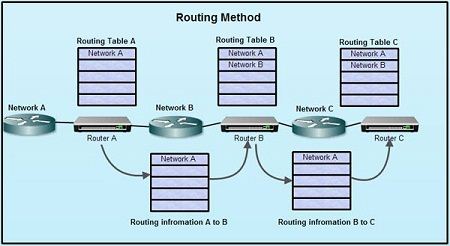The distance-vector routing Protocol is a type of algorithm used by routing protocols to discover routes on an interconnected network. The primary distance-vector routing protocol algorithm is the Bellman-Ford algorithm. Another type of routing protocol algorithm is the link-state approach.
Routing protocols that use distance-vector routing protocols include RIP (Routing Information Protocol), Cisco’s IGRP (Internet Gateway Routing Protocol), and Apple’s RTMP (Routing Table Maintenance Protocol). The most common link-state routing protocol is OSPF (Open Shortest Path First). Dynamic routing, as opposed to static (manually entered) routing, requires routing protocol algorithms.
Dynamic routing protocols assist in the automatic creation of routing tables. Network topologies are subject to change at any time. A link may fail unexpectedly, or a new link may be added. A dynamic routing protocol must discover these changes, automatically adjust its routing tables, and inform other routers of the changes.
The process of rebuilding the routing tables based on new information is called convergence. Distance-vector routing refers to a method for exchanging route information. A router will advertise a route as a vector of direction and distance.
Direction refers to a port that leads to the next router along the path to the destination, and distance is a metric that indicates the number of hops to the destination, although it may also be an arbitrary value that gives one route precedence over another. Inter network routers exchange this vector information and build route lookup tables from it.
Distance vector protocols are RIP, Interior Gateway Routing Protocol (IGPR).
Algorithm where each router exchanges its routing table with each of its neighbors. Each router will then merge the received routing tables with its own table, and then transmit the merged table to its neighbors. This occurs dynamically after a fixed time interval by default, thus requiring significant link overhead.

There are problems, however, such as:
- If exchanging data among routers every 90 seconds for example, it takes 90 x 10 seconds that a router detects a problem in router 10, routers ahead and the route cannot be changed during this period.
- Traffic increases since routing information is continually exchanged.
- There is a limit to the maximum amount of routing information (15 for RIP), and routing is not possible on networks where the number of hops exceeds this maximum.
- Cost data is only the number of hops, and so selecting the best path is difficult.
However, routing processing is simple, and it is used in small-scale networks in which the points mentioned above are not a problem.
RIP (Routing Information Protocol)
RIP is the most widely used routing protocol of distance-vector type today. It has been originally designed based on the routing protocol applied to XNS and PUP protocol systems of Xerox (RFC 1058).
- RIP request is used, by a router upon startup to inquire of its neighbor router about route information to obtain routing information.
- RIP response includes a destination host address and cost information in the address part. Response is sent to the neighbor router in case of the following:
- Receipt of RIP request
- Regularly
Response is sent every 30 seconds even if no RIP request is issued. All routers delete route information from their routing table if no route information is received within a specified period of time. This is intended to allow detection of fault of neighbor router.
- In case of changes made to routing table contents
If changes are made to the routing table because changes to the network configuration have been detected, information relating to these changes is sent to the neighbor router.
 Dinesh Thakur holds an B.C.A, MCDBA, MCSD certifications. Dinesh authors the hugely popular
Dinesh Thakur holds an B.C.A, MCDBA, MCSD certifications. Dinesh authors the hugely popular